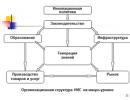Preparing for the OGE in chemistry manuals. Oge chemistry. Changes in demo versions of the OGE in chemistry
Task 1. Structure of the atom. The structure of the electronic shells of the atoms of the first 20 elements of D.I. Mendeleev’s periodic system.
Task 2. Periodic law and periodic system chemical elements DI. Mendeleev.
Task 3.The structure of molecules. Chemical bond: covalent (polar and nonpolar), ionic, metallic.
Task 4.
Task 5. Simple and complex substances. Main classes inorganic substances. Nomenclature of inorganic compounds.
Download:
Preview:
Exercise 1
The structure of the atom. The structure of the electronic shells of the atoms of the first 20 elements of D.I. Mendeleev’s periodic system.
How to determine the number of electrons, protons and neutrons in an atom?
- The number of electrons is equal to the atomic number and the number of protons.
- The number of neutrons is equal to the difference between the mass number and the atomic number.
The physical meaning of the serial number, period number and group number.
- Serial number equal to the number protons and electrons, nuclear charge.
- The A group number is equal to the number of electrons in the outer layer (valence electrons).
Maximum number of electrons in levels.
The maximum number of electrons at levels is determined by the formula N= 2 n 2.
Level 1 – 2 electrons, level 2 – 8, level 3 – 18, level 4 – 32 electrons.
Features of filling the electronic shells of elements of groups A and B.
For elements of the A group, valence (outer) electrons fill the last layer, and for elements of the B group, the outer electron layer and partially the outer layer.
Oxidation states of elements in higher oxides and volatile hydrogen compounds.
Groups | VIII |
|||||||
S.O. in higher oxide = + No. gr | ||||||||
Higher oxide | R 2 O | R 2 O 3 | RО 2 | R 2 O 5 | RO 3 | R 2 O 7 | RO 4 |
|
S.O. in LAN = No. gr - 8 | ||||||||
LAN | H 4 R | H 3 R | H 2 R |
Structure of electronic shells of ions.
A cation has fewer electrons per charge, while anions have more electrons per charge.
For example:
Ca 0 - 20 electrons, Ca2+ - 18 electrons;
S 0 – 16 electrons, S 2- - 18 electrons.
Isotopes.
Isotopes are varieties of atoms of the same chemical element that have the same number of electrons and protons, but different atomic masses ( different number neutrons).
For example:
Elementary particles | Isotopes |
|
40 Ca | 42Ca |
|
It is necessary to be able to use the D.I. table. Mendeleev to determine the structure of the electronic shells of the atoms of the first 20 elements.
Preview:
http://mirhim.ucoz.ru
A 2. B 1.
Periodic law and periodic system of chemical elements D.I. Mendeleev
Patterns of change chemical properties elements and their compounds in connection with their position in the periodic table of chemical elements.
Physical meaning of serial number, period number and group number.
The atomic (ordinal) number of a chemical element is equal to the number of protons and electrons and the charge of the nucleus.
The period number is equal to the number of filled electronic layers.
The group number (A) is equal to the number of electrons in the outer layer (valence electrons).
Forms of existence chemical element and their properties | Property Changes |
||
In the main subgroups (from top to bottom) | In periods (from left to right) |
||
Atoms | Core charge | Increases | Increases |
Number of energy levels | Increases | Does not change = period number |
|
Number of electrons in the outer level | Does not change = period number | Increases |
|
Atomic radius | Are increasing | Decreases |
|
Restorative properties | Are increasing | Are decreasing |
|
Oxidative properties | Decreases | Are increasing |
|
Higher positive degree oxidation | Constant = group number | Increases from +1 to +7 (+8) |
|
Lowest oxidation state | Doesn't change = (8-Group No.) | Increases from -4 to -1 |
|
Simple substances | Metallic properties | Increases | Are decreasing |
Non-metallic properties | Are decreasing | Increases |
|
Element connections | The nature of the chemical properties of higher oxide and higher hydroxide | Strengthening basic properties and weakening acidic properties | Strengthening acidic properties and weakening basic properties |
Preview:
http://mirhim.ucoz.ru
A 4
Oxidation state and valence of chemical elements.
Oxidation state– the conditional charge of an atom in a compound, calculated on the assumption that all bonds in this compound are ionic (that is, all bonding electron pairs are completely shifted towards the atom of a more electronegative element).
Rules for determining the oxidation state of an element in a compound:
- S.O. free atoms and simple substances is zero.
- The sum of the oxidation states of all atoms in a complex substance is zero.
- Metals have only positive S.O.
- S.O. alkali metal atoms (I(A) group) +1.
- S.O. atoms of alkaline earth metals (II (A) group)+2.
- S.O. boron atoms, aluminum +3.
- S.O. hydrogen atoms +1 (in hydrides of alkali and alkaline earth metals –1).
- S.O. oxygen atoms –2 (exceptions: in peroxides –1, in OF 2 +2 ).
- S.O. There are always 1 fluorine atoms.
- The oxidation state of a monatomic ion matches the charge of the ion.
- Highest (maximum, positive) S.O. element is equal to the group number. This rule does not apply to elements of the side subgroup of the first group, the oxidation states of which usually exceed +1, as well as to elements of the side subgroup of group VIII. They also don’t show their higher degrees oxidation equal to group number, elements oxygen and fluorine.
- Lowest (minimum, negative) S.O. for non-metal elements is determined by the formula: group number -8.
* S.O. – oxidation state
Valence of an atomis the ability of an atom to form a certain number of chemical bonds with other atoms. Valence has no sign.
Valence electrons are located on the outer layer of elements of A - groups, on the outer layer and d - sublevel of the penultimate layer of elements of B - groups.
Valences of some elements (indicated by Roman numerals).
permanent | variables |
||
HE | valence | HE | valence |
H, Na, K, Ag, F | Cl, Br, I | I (III, V, VII) |
|
Be, Mg, Ca, Ba, O, Zn | Cu, Hg | II, I |
|
Al, V | II, III |
||
II, IV, VI |
|||
II, IV, VII |
|||
III, VI |
|||
I - V |
|||
III, V |
|||
C, Si | IV (II) |
||
Examples of determining valency and S.O. atoms in compounds:
Formula | Valence | S.O. | Structural formula of the substance |
N III | N N |
||
NF 3 | N III, F I | N +3, F -1 | F-N-F |
NH 3 | N III, N I | N -3, N +1 | N - N - N |
H2O2 | H I, O II | H +1, O –1 | H-O-O-H |
OF 2 | O II, F I | O +2, F –1 | F-O-F |
*CO | C III, O III | C +2, O –2 | The “C” atom shared two electrons, and the more electronegative “O” atom pulled two electrons towards itself: “C” will not have the coveted eight electrons at the outer level - four of its own and two shared with the oxygen atom. Atom “O” will have to transfer one of its free electron pairs for general use, i.e. act as a donor. The acceptor will be the “C” atom. |
Preview:
A3. The structure of molecules. Chemical bond: covalent (polar and non-polar), ionic, metallic.
Chemical bonds are the forces of interaction between atoms or groups of atoms, leading to the formation of molecules, ions, free radicals, as well as ionic, atomic and metal crystal lattices.
Covalent bondis a bond that forms between atoms with the same electronegativity or between atoms with a small difference in electronegativity values.
A covalent nonpolar bond is formed between atoms of identical elements - nonmetals. A covalent nonpolar bond is formed if the substance is simple, e.g. O2, H2, N2.
A polar covalent bond is formed between atoms of different elements - nonmetals.
A polar covalent bond is formed if the substance is complex, for example SO 3, H 2 O, HCl, NH 3.
Covalent bonds are classified according to the mechanisms of formation:
exchange mechanism (due to shared electron pairs);
donor-acceptor (the donor atom has a free electron pair and shares it with another acceptor atom, which has a free orbital). Examples: ammonium ion NH 4 +, carbon monoxide CO.
Ionic bond formed between atoms that differ greatly in electronegativity. Typically, when metal and non-metal atoms combine. This is the connection between differently infected ions.
The greater the difference in the EO of atoms, the more ionic the bond.
Examples: oxides, halides of alkali and alkaline earth metals, all salts (including ammonium salts), all alkalis.
Rules for determining electronegativity using the periodic table:
1) from left to right across the period and from bottom to top through the group, the electronegativity of atoms increases;
2) the most electronegative element is fluorine, since noble gases have a complete external level and do not tend to give or accept electrons;
3) non-metal atoms are always more electronegative than metal atoms;
4) hydrogen has low electronegativity, although it is located at the top of the periodic table.
Metal connection– is formed between metal atoms due to free electrons that hold positively charged ions in the crystal lattice. This is the bond between positively charged metal ions and electrons.
Substances of molecular structurehave a molecular crystal lattice,non-molecular structure– atomic, ionic or metal crystal lattice.
Types of crystal lattices:
1) atomic crystal cell: formed in substances with covalent polar and non-polar bonds (C, S, Si), atoms are located at lattice sites, these substances are the hardest and most refractory in nature;
2) molecular crystal lattice: formed by substances with covalent polar and covalent non-polar bonds, there are molecules at the lattice sites, these substances have low hardness, are fusible and volatile;
3) ionic crystal lattice: formed in substances with an ionic bond, there are ions at the lattice sites, these substances are solid, refractory, non-volatile, but to a lesser extent than substances with an atomic lattice;
4) metal crystal lattice: formed in substances with a metallic bond, these substances have thermal conductivity, electrical conductivity, malleability and metallic luster.
Preview:
http://mirhim.ucoz.ru
A5. Simple and complex substances. Main classes of inorganic substances. Nomenclature of inorganic compounds.
Simple and complex substances.
Simple substances are formed by atoms of one chemical element (hydrogen H 2, nitrogen N 2 , iron Fe, etc.), complex substances - atoms of two or more chemical elements (water H 2 O – consists of two elements (hydrogen, oxygen), sulfuric acid H 2 SO 4 – formed by atoms of three chemical elements (hydrogen, sulfur, oxygen)).
Main classes of inorganic substances, nomenclature.
Oxides – complex substances consisting of two elements, one of which is oxygen in the oxidation state -2.
Nomenclature of oxides
The names of oxides consist of the words "oxide" and the name of the element in genitive case(indicating the oxidation state of the element in Roman numerals in parentheses): CuO – copper (II) oxide, N 2 O 5 – nitric oxide (V).
Character of oxides:
HE | basic | amphoteric | non-salt-forming | acid |
metal | S.O.+1,+2 | S.O.+2, +3, +4 amph. Me – Be, Al, Zn, Cr, Fe, Mn | S.O.+5, +6, +7 |
|
non-metal | S.O.+1,+2 (excl. Cl 2 O) | S.O.+4,+5,+6,+7 |
Basic oxides form typical metals with C.O. +1, +2 (Li 2 O, MgO, CaO, CuO, etc.). Basic oxides are called oxides to which bases correspond.
Acidic oxidesform nonmetals with S.O. more than +2 and metals with S.O. +5 to +7 (SO 2, SeO 2, P 2 O 5, As 2 O 3, CO 2, SiO 2, CrO 3 and Mn 2 O 7 ). Oxides that correspond to acids are called acidic.
Amphoteric oxidesformed by amphoteric metals with C.O. +2, +3, +4 (BeO, Cr 2 O 3 , ZnO, Al 2 O 3 , GeO 2 , SnO 2 and PHO). Oxides that exhibit chemical duality are called amphoteric.
Non-salt-forming oxides– non-metal oxides with С.О.+1,+2 (СО, NO, N 2 O, SiO).
Grounds ( basic hydroxides) - complex substances that consist of
A metal ion (or ammonium ion) and a hydroxyl group (-OH).
Nomenclature of bases
After the word “hydroxide” the element and its oxidation state are indicated (if the element exhibits a constant oxidation state, then it may not be indicated):
KOH – potassium hydroxide
Cr(OH) 2 – chromium (II) hydroxide
The bases are classified:
1) according to their solubility in water, bases are divided into soluble (alkalies and NH 4 OH) and insoluble (all other bases);
2) according to the degree of dissociation, bases are divided into strong (alkalis) and weak (all others).
3) by acidity, i.e. according to the number of hydroxo groups that can be replaced by acidic residues: one-acid (NaOH), two-acid, three-acid.
Acidic hydroxides (acids)- complex substances that consist of hydrogen atoms and an acid residue.
Acids are classified:
a) according to the content of oxygen atoms in the molecule - into oxygen-free (H C l) and oxygen-containing (H 2SO4);
b) by basicity, i.e. number of hydrogen atoms that can be replaced by a metal - monobasic (HCN), dibasic (H 2 S) etc.;
c) according to electrolytic strength - into strong and weak. The most commonly used strong acids are dilute aqueous solutions HCl, HBr, HI, HNO 3, H2S, HClO4.
Amphoteric hydroxidesformed by elements with amphoteric properties.
Salts - complex substances formed by metal atoms combined with acidic residues.
Medium (normal) salts- iron(III) sulfide.
Acid salts - hydrogen atoms in the acid are partially replaced by metal atoms. They are obtained by neutralizing a base with an excess of acid. To name it correctly sour salt, it is necessary to add the prefix hydro- or dihydro- to the name of a normal salt, depending on the number of hydrogen atoms included in the acid salt.
For example, KHCO 3 – potassium bicarbonate, KH 2PO 4 – potassium dihydrogen orthophosphate
It must be remembered that acid salts can form two or more basic acids, both oxygen-containing and oxygen-free acids.
Basic salts - hydroxyl groups of the base (OH− ) are partially replaced by acidic residues. To name basic salt, it is necessary to add the prefix hydroxo- or dihydroxo- to the name of a normal salt, depending on the number of OH groups included in the salt.
For example, (CuOH)2CO3 - copper (II) hydroxycarbonate.
It must be remembered that basic salts can only form bases containing two or more hydroxo groups.
Double salts - they contain two different cations; they are obtained by crystallization from a mixed solution of salts with different cations, but the same anions.
Mixed salts - they contain two different anions.
Hydrate salts ( crystal hydrates ) - they contain crystallization moleculeswater . Example: Na 2 SO 4 10H 2 O.
The reference book contains theoretical material on the course of chemistry and test tasks necessary to prepare for the State final certification of the OGE for 9th grade graduates educational organizations. The theory of the course is given in a concise and accessible form. Each section is accompanied by example tests. Practical tasks correspond to the OGE format. They give a comprehensive idea of the types of tasks in the examination paper and their degree of difficulty. At the end of the manual, answers to all tasks are given, as well as the necessary reference tables.
The manual can be used by students to prepare for the Unified State Examination and self-control, and by teachers to prepare primary school students for the final certification in chemistry. The book is addressed to students, teachers and methodologists.
Nucleus of an atom. Nucleons. Isotopes.
An atom is the smallest particle of a chemical element. For a long time, atoms were considered indivisible, as reflected in their very name (“atomos” in Greek means “uncut, indivisible”). Experimental studies, carried out in late XIX- the beginning of the 20th century by the famous physicists W. Crookes, V.K. Roentgen, A. Becquerel, J. Thomson, M. Curie, P. Curie, E. Rutherford and others convincingly proved that the atom is a complex system consisting of smaller particles, the first of which were discovered by electrons. At the end of the 19th century. It was found that some substances, under strong illumination, emit rays, which were a stream of negatively charged particles, which were called electrons (the phenomenon of the photoelectric effect). Later it was found that there are substances that spontaneously emit not only electrons, but also other particles, not only when illuminated, but also in the dark (the phenomenon of radioactivity).
By modern ideas, in the center of the atom there is a positively charged atomic nucleus, around which negatively charged electrons move in complex orbits. The dimensions of the nucleus are very small - the nucleus is approximately 100,000 times smaller than the size of the atom itself. Almost the entire mass of an atom is concentrated in the nucleus, since electrons have a very small mass - they are 1837 times lighter than a hydrogen atom (the lightest of the atoms). The electron is the lightest known elementary particles, its total mass
9.11 10 -31 kg. Since the electric charge of an electron (equal to 1.60 10 -19 C) is the smallest of all known charges, it is called the elementary charge.
By buttons above and below “Buy a paper book” and using the “Buy” link you can buy this book with delivery throughout Russia and similar books at the best price in paper form on the websites of the official online stores Labyrinth, Ozon, Bookvoed, Read-Gorod, Litres, My-shop, Book24, Books. ru.
By clicking the “Buy and download e-book” button, you can buy this book in electronic form in the official liters online store, and then download it on the liters website.
OGE series. FIPI - school was prepared by the developers of control measurement materials (CMM) for the main state exam. The collection contains:
24 thematic options for all sections of the OGE codifier in chemistry;
10 standard exam options, compiled in accordance with the draft demo version of the KIM OGE in chemistry 2015;
instructions for completing the examination work;
answers to all tasks;
evaluation criteria.
Thematic options provide the opportunity to systematically prepare students for the state final certification in the 9th grade in the form of the OGE, and completing tasks of standard exam options - to objectively assess the level of their preparation for the exam.
Teachers can use thematic and standard examination options to organize monitoring of the results of schoolchildren’s mastery of educational programs of the basic general education and intensive preparation of students for the OGE.
Examples of tasks:
When completing task 8, from the proposed list of answers, select two correct ones and write down the numbers under which they are indicated in the table.
TO physical phenomena relate:
1) food burning
2) gas release when acid hits chalk
3) gas release when opening a bottle of lemonade
4) blackening of the copper plate when heated
5) melting of the candle when heated
Answer:
When completing tasks 9, 10, for each element of the first column, select the corresponding element from the second column. Write down the selected numbers in the table under the corresponding letters. The numbers in the answer may be repeated.
Content
Introduction.
THEMATIC OPTIONS
Topic 1. Initial chemical concepts.
Option 1.
Option 2.
Option 3.
Option 4.
Topic 2. Periodic law and Periodic table chemical elements D.I. Mendeleev.
Specification of options on the topic.
Option 1.
Option 2.
Option 3.
Option 4.
Topic 3. Electrolytic dissociation. Ion exchange reactions. Redox reactions.
Specification of options on the topic.
Option 1.
Option 2.
Option 3.
Option 4.
Topic 4. Metals and their compounds.
Specification of options on the topic.
Option 1.
Option 2.
Option 3.
Option 4.
Topic 5. Nonmetals and their compounds.
Specification of options on the topic.
Option 1.
Option 2.
Option 3.
Option 4.
Topic 6. Knowledge and application of substances and chemical reactions..
Specification of options on the topic.
Option 1.
Option 2.
Option 3.
Option 4.
STANDARD EXAMINATION OPTIONS
Instructions for performing the work.
Option 1.
Option 2.
Option 3.
Option 4.
Option 5.
Option 6.
Option 7.
Option 8.
Option 9.
Option 10.
ANSWERS
Answers to thematic options.
Answers to standard exam options.
Answers to short answer assignments (part 1).
Answers and criteria for assessing the completion of tasks with a detailed answer (part 2).
Download the e-book for free in a convenient format, watch and read:
Download the book OGE, chemistry, thematic and standard exam options, 34 options, Dobrotin D.Yu., 2015 - fileskachat.com, fast and free download.
- Codifier of verifiable requirements for the results of mastering the main educational program of basic general education and content elements for the main state exam in CHEMISTRY, 2020
- OGE, Chemistry, Preparing for the final certification, Dobrotin D.Yu., Molchanova G.N., 2020
- Chemistry, Main state exam, Preparing for the final certification, Dobrotin D.Yu., Molchanova G.N., 2020
- OGE 2020, Chemistry, 9th grade, Specification, Codifier, Project
The following textbooks and books:
- Chemistry, 8th grade, Tests and independent works, to the textbook by Gabrielyan O.S. "Chemistry. 8th grade”, Gabrielyan O.S., Pavlova N.S., 2015
■ Is there a guarantee that after classes with you we will pass the OGE in chemistry with the required score?
More than 80% ninth graders who passed through me full course preparing for the OGE and regularly completing homework, they passed this exam with flying colors! And this despite the fact that even 7-8 months before the exam, many of them could not remember the formula of sulfuric acid and confused the solubility table with the periodic table!
■ It’s already January, knowledge of chemistry is at zero. Is it too late or is there still a chance to pass the OGE?
There is a chance, but only on condition that the student is ready to work seriously! I'm not shocked by the zero level of knowledge. Moreover, most ninth-graders are preparing for the Unified State Exam. But you need to understand that miracles do not happen. Without active work The student will not get the knowledge “by itself” in his head.
■ Is preparing for the OGE in chemistry very difficult?
First of all, it's very interesting! I cannot call the OGE in chemistry a difficult exam: the tasks offered are quite standard, the range of topics is known, the assessment criteria are “transparent” and logical.
■ How it works OGE exam in chemistry?
There are two versions of the OGE: with and without the experimental part. In the first version, schoolchildren are offered 23 tasks, two of which are related to practical work. 140 minutes are allotted to complete the work. In the second option, 22 problems must be solved in 120 minutes. 19 tasks require only a short answer, the rest require a detailed solution.
■ How (technically) can I sign up for your classes?
Very simple!
- Call me on: 8-903-280-81-91 . You can call any day until 23.00.
- We will arrange a first meeting for preliminary testing and to determine the level of the group.
- You choose the lesson time and group size that is convenient for you (individual lessons, pair lessons, mini-groups).
- That's it, work begins at the appointed time.
Good luck!
Or you can simply use it on this site.
■ What is the best way to prepare: in a group or individually?
Both options have their advantages and disadvantages. Classes in groups are optimal in terms of price-quality ratio. Individual lessons allow for a more flexible schedule and finer “tuning” of the course to the needs of a particular student. After preliminary testing I will recommend you the best option, but the final choice is yours!
■ Do you go to students’ homes?
Yes, I'm leaving. To any district of Moscow (including areas beyond the Moscow Ring Road) and to the near Moscow region. Not only individual but also group lessons can be conducted at students’ homes.
■ And we live far from Moscow. What to do?
Study remotely. Skype is our best assistant. Distance classes are no different from face-to-face classes: the same methodology, the same educational materials. My login: repetitor2000. Contact us! Let's do a trial lesson and see how simple it is!
■ When can classes start?
Basically, any time. The ideal option is a year before the exam. But even if there are several months left before the OGE, contact us! There may be some openings left and I can offer you an intensive course. Call: 8-903-280-81-91!
■ Does good preparation for the OGE guarantee successful passing the Unified State Exam in chemistry in the eleventh grade?
Doesn't guarantee it, but it greatly contributes to it. The foundation of chemistry is laid precisely in grades 8-9. If a student masters the basic sections of chemistry well, it will be much easier for him to study in high school and prepare for the Unified State Exam. If you are planning to enter a university with high level requirements in chemistry (MSU, leading medical universities), preparation should begin not a year before the exam, but already in grades 8-9!
■ How much will the OGE-2020 in chemistry differ from the OGE-2019?
No changes are planned. There are two options for the exam: with or without a practical part. The number of tasks, their topics, and the assessment system remain the same as they were in 2019.
For schoolchildren who plan to master a profession related to chemistry in the future, the OGE in this subject is very important. If you want to score better in your test, start preparing immediately. The best number of points for completing the work is 34. The indicators of this exam can be used when sending to specialized classes high school. Moreover, the minimum limit of the indicator in terms of points in this case is 23.
What are the options?
The OGE in chemistry, as in previous years, includes theory and practice. With the help of theoretical tasks, they test how well boys and girls know the basic formulas and definitions of organic and inorganic chemistry and how to apply them in practice. The second part is accordingly aimed at testing the ability of schoolchildren to carry out redox and ion exchange reactions, to have an idea of molar masses and volumes of substances.
Why you need to get tested
OGE 2020 in chemistry requires serious preparation, since the subject is quite complex. Many have already forgotten the theory, perhaps they did not understand it well, and without it it is impossible to correctly solve the practical part of the task.
It is worth taking the time to train now in order to show decent results in the future. Today, schoolchildren have an excellent opportunity to evaluate their strength by solving last year’s real tests. There are no costs - you can use school knowledge for free and understand how the exam will be held. Students will be able not only to repeat the material covered and complete the practical part, but also to feel the atmosphere of real tests.
Convenient and efficient
An excellent opportunity is to prepare for the OGE right at the computer. You just need to press the start button and start taking tests online. This is very effective and can replace classes with a tutor. For convenience, all tasks are grouped by ticket numbers and fully correspond to the real ones, since they were taken from the website Federal Institute pedagogical measurements.
If you are not confident in your abilities, you are afraid of upcoming tests, you have gaps in theory, you have not completed enough experimental tasks - turn on the computer and start preparing. We wish you success and the highest grades!






